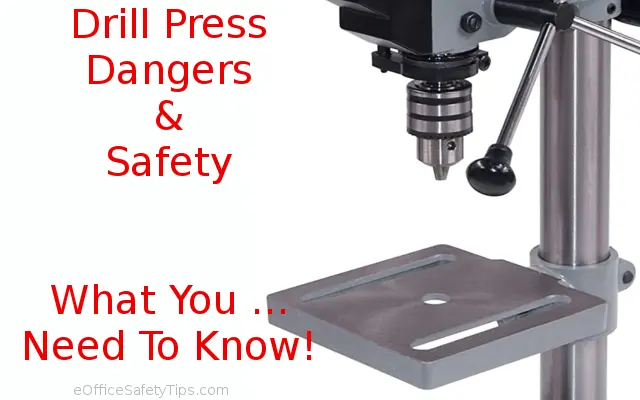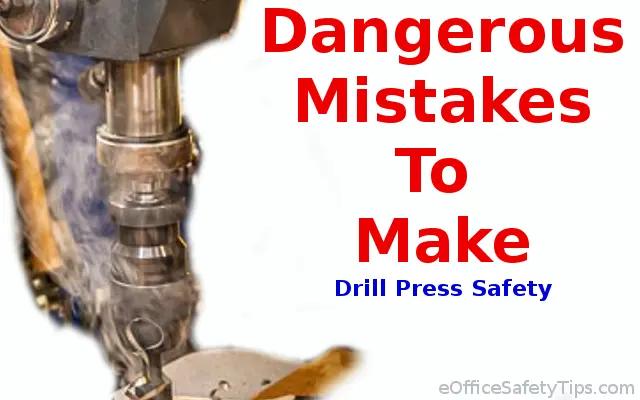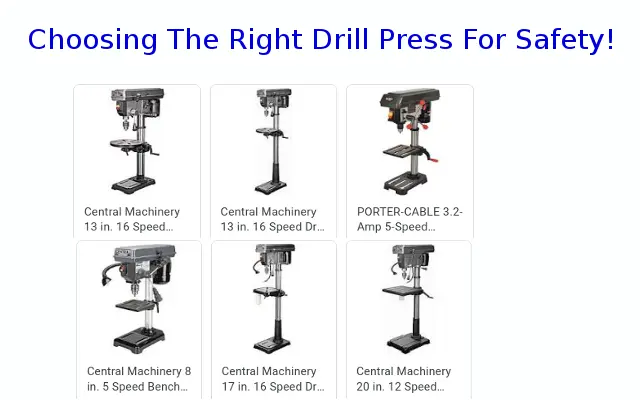Drill Press Dangers - How to Stay Safe While Using a Drill Press
Drill presses are powerful and versatile tools that can be used for a wide variety of projects, from woodworking to metalworking and more. However, like any power tool, they can also pose serious safety risks if not used properly. From flying debris to electrical hazards, there are a number of dangers associated with using a drill press that must be taken seriously to prevent injury or worse.

In this comprehensive guide, we will explore the most common dangers associated with drill press use and provide practical tips and advice for staying safe while using this powerful tool. Whether you're a seasoned pro or a beginner, there is always more to learn when it comes to drill press safety, and we're here to help you stay informed and protected. So let's dive in and discover how to use a drill press safely and effectively!
Be sure to checkout the bottom resource section where you can find several free resources you can use as an aid to creating a safe work environment.
The Importance of Drill Press Safety
When using a drill press, it's important to prioritize safety above all else. The drill press is a powerful tool that can cause serious injury or even death if not used properly. Here are some of the dangers associated with using a drill press:
- Getting your fingers caught in the drill bit
- Accidentally drilling into your hand or arm
- Getting hit by flying debris
- Getting your hair or clothing caught in the drill bit
- Electric shock or electrocution
As you can see, the dangers associated with using a drill press are significant. However, by following some simple safety tips and best practices, you can greatly reduce the risk of injury and ensure a safe and enjoyable drilling experience.

A drill press is a powerful tool that can be used for a wide range of drilling and milling tasks. However, it's important to remember that drill presses can also be dangerous if not used properly. The high-speed rotation of the drill bit can cause debris to fly into your eyes, and loose clothing or jewelry can get caught in the moving parts and cause serious injury.
To avoid these and other potential hazards, it's essential to follow basic safety guidelines when using a drill press. This includes wearing eye protection, securing the workpiece to the table, and using the appropriate drill bit for the material you are drilling. By taking these simple precautions and using common sense when operating a drill press, you can minimize the risk of injury and enjoy a safe and productive drilling experience.
Drill Press Safety Tips
Now that you understand why drill press safety is so important, let's take a closer look at some specific safety tips to keep in mind when operating a drill press.
First and foremost, always wear eye protection when using a drill press. The high-speed rotation of the drill bit can cause chips and debris to fly into your eyes, potentially causing serious injury or even blindness. In addition to eye protection, it's also a good idea to wear gloves to protect your hands from hot metal chips and other debris that may be generated during drilling.
Another key safety tip is to secure the workpiece to the table using clamps or other fasteners. This helps to prevent the workpiece from spinning or shifting during use, which could cause the drill bit to bind and kick back. In addition, it's important to use the appropriate drill bit for the material you are drilling, and to ensure that it is properly secured in the chuck. Finally, always adjust the drill press speed to match the type of material you are drilling, as using the wrong speed can cause the drill bit to overheat and break.
A drill press is a powerful and versatile tool that can be used for a variety of drilling and milling tasks. However, it can also be a dangerous tool if not used properly. Here are some key safety tips to keep in mind when using a drill press:
- Wear eye protection to prevent debris from flying into your eyes.
- Keep loose clothing and jewelry away from the drill bit and other moving parts.
- Secure the workpiece to the table using clamps or other fasteners to prevent it from spinning or shifting during use.
- Use the appropriate drill bit for the material you are drilling and ensure it is properly secured in the chuck.
- Adjust the drill press speed to match the type of material you are drilling.
- Avoid using excessive force when feeding the workpiece into the drill bit, as this can cause the bit to bind and kick back.
By following these safety tips and using common sense when operating a drill press, you can avoid injury and enjoy a safe and productive drilling experience.
Common Drill Press Mistakes and How to Avoid Them
Even experienced drill press users can make mistakes that can lead to injury or damage to the work-piece. Here are some common mistakes to avoid:
- Forgetting to secure the work-piece properly, which can cause it to slip or spin during drilling
- Using the wrong drill bit for the material, which can cause the bit to break or become damaged
- Using excessive force or speed, which can cause the bit to overheat or break
- Not using enough lubricant or coolant, which can cause the bit to become dull or damaged
Despite the importance of drill press safety, many people still make common mistakes that can lead to injury or damage to the equipment. Here are a few of the most common mistakes, along with tips for how to avoid them:
One common mistake is failing to use the appropriate drill bit for the material being drilled. Using the wrong type of bit can result in poor performance, damaged materials, and potentially dangerous situations. To avoid this mistake, always make sure you are using the appropriate bit for the job, and if you are unsure, consult a drill bit chart or consult with a professional.
Another mistake is neglecting to adjust the drill press speed to match the material being drilled. Using the wrong speed can cause the bit to overheat, dull more quickly, or even break, which can be both dangerous and costly. To avoid this mistake, consult the drill bit manufacturer's recommendations for the appropriate speed, and adjust the drill press accordingly.
Other common mistakes include failing to secure the workpiece properly, which can cause it to spin or shift during drilling, and neglecting to use proper eye and hand protection, which can result in injury or damage to the equipment. By being aware of these common mistakes and taking the appropriate precautions, you can avoid potential hazards and enjoy a safe and productive drilling experience.
Choosing the Right Drill Press for Your Needs
Not all drill presses are created equal. When selecting a drill press for your needs, consider the following factors:
- The size and weight of the workpiece you'll be drilling
- The size and type of drill bit you'll be using
- The maximum drilling depth you'll need
- The available space in your workshop
- Your budget

When it comes to selecting the right drill press for your needs, there are a number of factors to consider. The first consideration is the type of work you will be doing. For lighter-duty projects, a benchtop drill press may be sufficient, while larger projects may require a floor-standing model. Additionally, you will want to consider the maximum drilling capacity and the motor size of the drill press, as these factors will determine the types of materials and the thickness of material that can be drilled.
Another important factor to consider when choosing a drill press is the type of chuck it uses. Keyed chucks are the traditional choice and are well-suited for heavy-duty drilling, while keyless chucks are becoming increasingly popular for their ease of use and convenience. Additionally, you may want to consider features such as variable speed control, digital depth displays, and laser guides, which can make drilling more precise and efficient.
Finally, it's important to consider the overall quality and durability of the drill press you choose, as this will impact both its performance and its longevity. Look for models with solid construction, high-quality components, and good reviews from other users to ensure that you are making a wise investment.
By considering these factors and doing some research on the various types and brands of drill presses available, you can find the right drill press for your needs and ensure a safe and productive drilling experience.
Conclusion: How To Avoid Drill Press Dangers, Mistakes & Accidents
Drill presses are powerful and versatile tools, but they can also be dangerous if not used properly. By following the safety tips and best practices outlined in this guide, you can stay safe while using a drill press and avoid injury or damage to your workpiece. Remember to always prioritize safety when using a drill press, and don't hesitate to seek out additional resources or training if you have any questions or concerns.
In conclusion, drill presses are incredibly useful tools for a wide variety of projects, but they can also pose serious safety risks if not used properly. By following some basic safety tips, avoiding common mistakes, and choosing the right drill press for your needs, you can enjoy the benefits of this powerful tool without putting yourself or others in harm's way.
Remember to always wear appropriate safety gear, such as eye protection and gloves, and to secure your workpiece properly before drilling. Use the appropriate drill bit and adjust the speed of the drill press to match the material being drilled, and be mindful of any warning signs such as smoke or strange noises. Finally, invest in a high-quality, durable drill press that meets your specific needs and has a good track record of performance.
By taking these precautions and being mindful of the potential risks, you can enjoy a safe and productive experience with your drill press for years to come.
Drill Press Safety Resources:
Below we have compiled free drill press safety and danger prevention resources to help you both learn visually, and help keep safety first! Additionally you can find some free resources that you are free to download and use at your leisure. Below you can find both a checklist outlining dangers to avoid, as well as what to do in an emergency. Both are PDF Docs that can be downloaded free, printed, and posted in your workplace to encourage safety practices.
Drill Press Dangers Checklist
Download and print out this free drill press safety checklist to help remind you and your coworkers about the important safety measures that should be taken when operating a drill press. Follow these simple steps to help prevent accidents and injuries in the workplace.
Printable Drill Press Emergency Response Guide
This Emergency Response Guide is a printable resource that can be posted in a prominent location in the workplace to provide clear and concise steps to follow in the event of a drill press accident. It includes steps such as calling for medical assistance, turning off the drill press and other equipment involved, securing the area, gathering necessary information, and following up with any required reporting or paperwork. By having this guide readily available, workers can quickly and effectively respond to emergencies and ensure the safety of everyone in the workplace.
Download this free printable emegency response guide to help avoid drill press dangers and promote safe handling and use of drill presses.
Drill Press Danger Videos
Below is a great video about the dangers of drill press safety, seen and explained first hand by someone who has been working with drill presses safely for quite some time.
And this is helpful for learning the safety ropes and avoiding dangerous situations that arise from working with a drill press right from the start! This is about a 10 minute video covering the various safety aspects of drill presses and working with them.
